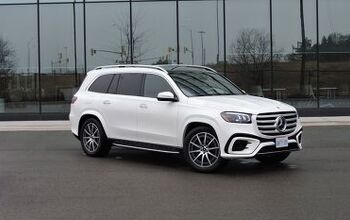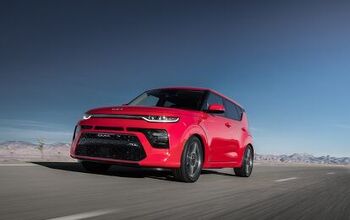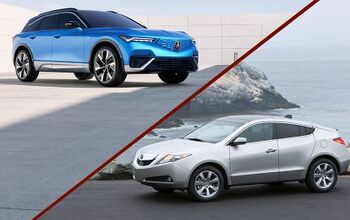Five-Point Inspection: 2012 Jeep Compass Latitude 4 X 4

The subject of our latest Five-Point Inspection is the 2012 Jeep Compass, outfitted in the Latitude trim, with the optional 4×4 system, CVT transmission and plenty of extras.
Jeep ditched the ugly old front end we saw during our previous encounter with the Compass for a handsome new mug that looks more like the Grand Cherokee. Chrome accents outlining the grille vents and headlights that imitate the more luxurious (and expensive) SUV give the final generation of Jeep’s trucklette a more presentable look. Combined with the red paint and slick-looking alloy wheels, the Compass is finally something you don’t need to feel embarrassed to be seen in.
The rear bumper loses the “Compass” logo, which is a nice touch, though Jeep understandably kept the tiny rear quarter window and ugly black plastic handles for the rear passenger doors. We would have been surprised to find that changed considering the model has been cancelled.
Our test vehicle came with optional tow hooks as well, though its tough to imagine pulling anyone out of the mud or snow with such a relatively weak engine.
That engine is a 2.4-liter inline four-cylinder with 172 hp mated to a continuously variable transmission. Along with the new look, Jeep added a crawling ratio to the transmission in an effort to increase the car’s off-road credibility though the fact remains that this is far from being a Wrangler. That being said, the Compass handled a two-track patch with ease, taking soft spots gracefully with four-wheel drive engaged.
Lower gearing and a “trail rated” badge are part of the off-road package, but after living with it for a week we would pass on the upgrade every time. You’re probably never going to take the Compass into serious off-road territory – it doesn’t have the ground clearance or power to feel comfortable there and does have the disadvantage of the “Freedom II” package that whacks everyday gas mileage down to abysmal figures. During city driving we struggled to squeak out 16 mpg and a frustrating 21 on the open highway. Driving a nannyish 50 mph we managed to get 25 mpg, but you risk being pulled over for driving too slow in some parts of the country at that pace.
Realistically, the Compass is a suburban pavement pounder built for year-round grocery runs. Don’t fool yourself into thinking otherwise: skip the off-road package and enjoy the better fuel economy.
Considering the starting price, the Compass comes with acceptable interior quality, though you’ll never forget that you’re in a relatively cheap car. Little touches like illuminated cup holders and removable rubber liners in most of the compartments make the cabin easy to clean.
Unfortunately, the seats (front and rear) are uncomfortable on long drives. The front buckets completely lack lumbar support while the rears are board-flat and feel cramped to most adults. Jeep also put two cup holders over the drive shaft hump in the rear, so bringing a fifth passenger will be either awkward or out of the question.
On the other hand, those seats both recline and fold flat, to create a spacious rear cargo area or slightly more tolerable riding condition for the taller members of your entourage.
Punching the gas pedal from a stand still gives adequate power when it’s needed, but you’ll never forget that it’s a four cylinder. Jumping from a line of stopped cars into live traffic is downright stressful, especially because there isn’t a manual gearing mode on the CVT transmission.
Another downfall of the CVT is that at higher speeds (80 mph) the car feels near its limits both in terms of power and refinement. Going any faster than that probably means you’re speeding, so maybe that’s not a bad thing, but we’re solid proponents for having the horsepower to move out of a dangerous situation when you need to and that’s not the case here. Again, the CVT makes the car buzzy at high rpm, hurting the car’s cruising comfort.
Our model came with options like an improved stereo with a touch screen, a sunroof, the off-road package and more to drive the price well above its $19,295 starting MSRP – and at well below the fuel mileage we would have appreciated from a four-cylinder engine.
While the Compass was by no means bad to drive, it’s understandable why Jeep is cutting it from the lineup. Competition from similarly-sized options like the Honda CR-V offer four-wheel drive, better fuel economy, on-par pricing and a better overall experience. The improved interior and exterior help the Compass stay relevant but it’s perhaps trying too hard to stick to the Jeep off-road mantra while delivering too little on-road to be worth the cash.

Luke is an energetic automotive journalist who spends his time covering industry news and crawling the internet for the latest breaking story. When he isn't in the office, Luke can be found obsessively browsing used car listings, drinking scotch at his favorite bar and dreaming of what to drive next, though the list grows a lot faster than his bank account. He's always on <A title="@lukevandezande on Twitter" href="http://twitter.com/lukevandezande">Twitter</A> looking for a good car conversation. Find Luke on <A title="@lukevandezande on Twitter" href="http://twitter.com/lukevandezande">Twitter</A> and <A title="Luke on Google+" href="http://plus.google.com/112531385961538774338?rel=author">Google+</A>.
More by Luke Vandezande





































Comments
Join the conversation